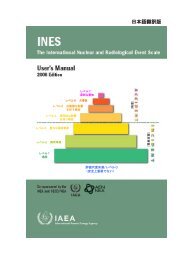Guidelines for Iodine Prophylaxis following Nuclear Accidents
Iodine_Prophylaxis_guide
Iodine_Prophylaxis_guide
You also want an ePaper? Increase the reach of your titles
YUMPU automatically turns print PDFs into web optimized ePapers that Google loves.
<strong>Guidelines</strong> <strong>for</strong> iodine prophylaxis <strong>following</strong> nuclear accidents1999 updateNeonatesNewborn infants are quite likely the critical group of concern whendeciding on the implementation of stable iodine prophylaxis. In thefirst few days of life they are at special risk both of exposure fromradioactive iodine and blocking of thyroid function by an overload ofstable iodine.After birth, there is a dramatic increase in thyroid activity, lasting onlya couple of days. The fraction of radioactive iodine intake that will beincorporated into the thyroid at this critical stage can be fourfoldgreater than <strong>for</strong> all other age groups (15). On the other hand, duringthis period the thyroid is especially sensitive to the functional blockingcaused by an overload of stable iodine. The most critical period <strong>for</strong>developing thyroid blockage lasts <strong>for</strong> less than a week, even in thepremature. Even transient hypothyroidism during the critical period ofbrain development can result in loss of intellectual capacity (16). Thepotential <strong>for</strong> harmful influence on neurointellectual development,however, was not confirmed in the Polish study referred to insection 2.3.When indicated, stable iodine in the <strong>for</strong>m of potassium iodide (KI)will be promptly given to all neonates. The dosage is critical. A singleadministration of 12.5 mg iodine (16 mg KI) should not be exceeded.If stable iodine is given, close follow-up is essential.KI solution should be readily available in maternity hospitals. Thiswill enable prompt and exact dosage to the critical group of thenewborn still on the ward. A few days later the sensitivity <strong>for</strong>blockage of thyroid function will have decreased and dosage may beper<strong>for</strong>med at home, by dividing, crushing and suspending tablets inmilk or water. In infants who have been administered stable iodine inthe first weeks of life, TSH levels and, if indicated, T 4 levels will bemonitored and appropriate replacement therapy given.Infants, children and adolescents (1 month to 18 years)These groups are at high risk from exposure to radioactive iodine butat very low risk from stable iodine. The dose to the thyroid fromradioactive iodine in a given situation will be higher in this group thanin adults because of the smaller size of the gland, which is only partlycompensated <strong>for</strong> by a smaller breathing volume. The highest dose10






